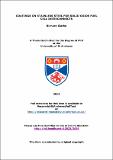Coatings on stainless steel for solid oxide fuel cell interconnects
Abstract
Enabling inexpensive and ubiquitous steels for use as solid oxide fuel cell interconnects has two major hurdles to overcome. Firstly, corrosion must be limited such that the interconnect can have longevity. Secondly, the evaporation of chromium from the corrosion layer must
also be limited such that the fuel cell can have longevity. The evaporation of chromium from chromia, titanium doped chromia, and chromium cobalt spinels was studied and characterized. Spinels lost the least amount of mass during evaporation experiments, and changed the least after experimental conditions were imposed on them that. Chromium titanate samples retained a significant amount of chrome that
would have evaporated had the sample been chromium oxide alone. This was due to local
changes at the surface with titanium becoming enriched and blocking loss of further chromium. Various methods of depositing titanium doped chromia on the surface of SS430 were investigated. Sol-gel was attempted, but proved problematic. Evaporation of elemental titanium onto SS430 followed by conversion to rutile by heating followed by the evaporation of chromium into the rutile layer was investigated at length. These layers are nanoscale when evaporated and about 10 times thicker after oxidation. Characterization of the resulting Ti layers showed that at low temperatures a thick dense layer of rutile could be observed. At higher oxidation temperatures, the titanium was difficult to find. Evaporation of cobalt onto SS430 created thin films when oxidized. The films were shown to control the evaporation of chromium by production of spinels. These layers were characterized with X-Ray Diffraction and scanning electron microscopy and impedance spectroscopy. They were shown to be quite conductive compared to the titanium coatings.
Type
Thesis, PhD Doctor of Philosophy
Collections
Items in the St Andrews Research Repository are protected by copyright, with all rights reserved, unless otherwise indicated.

